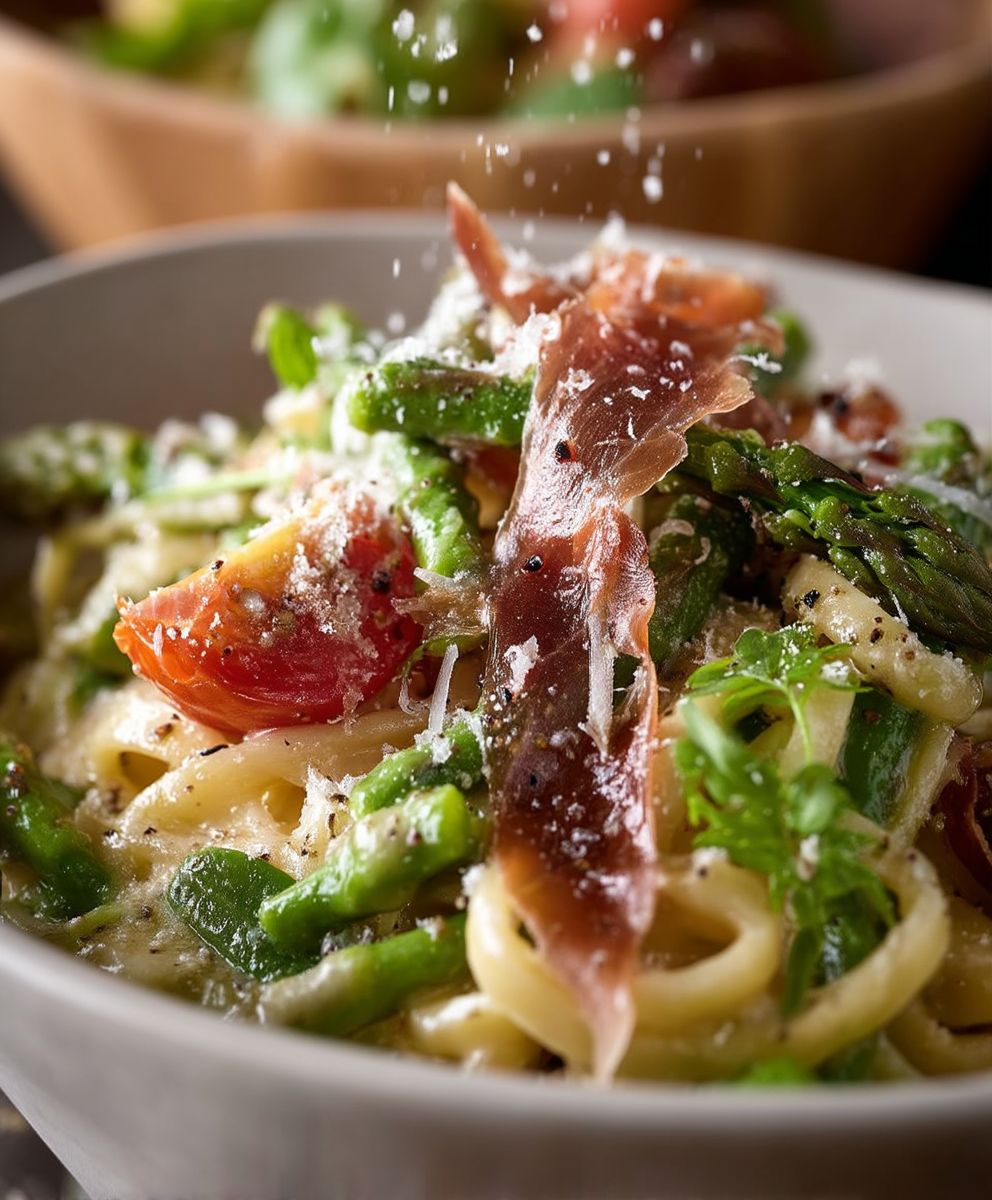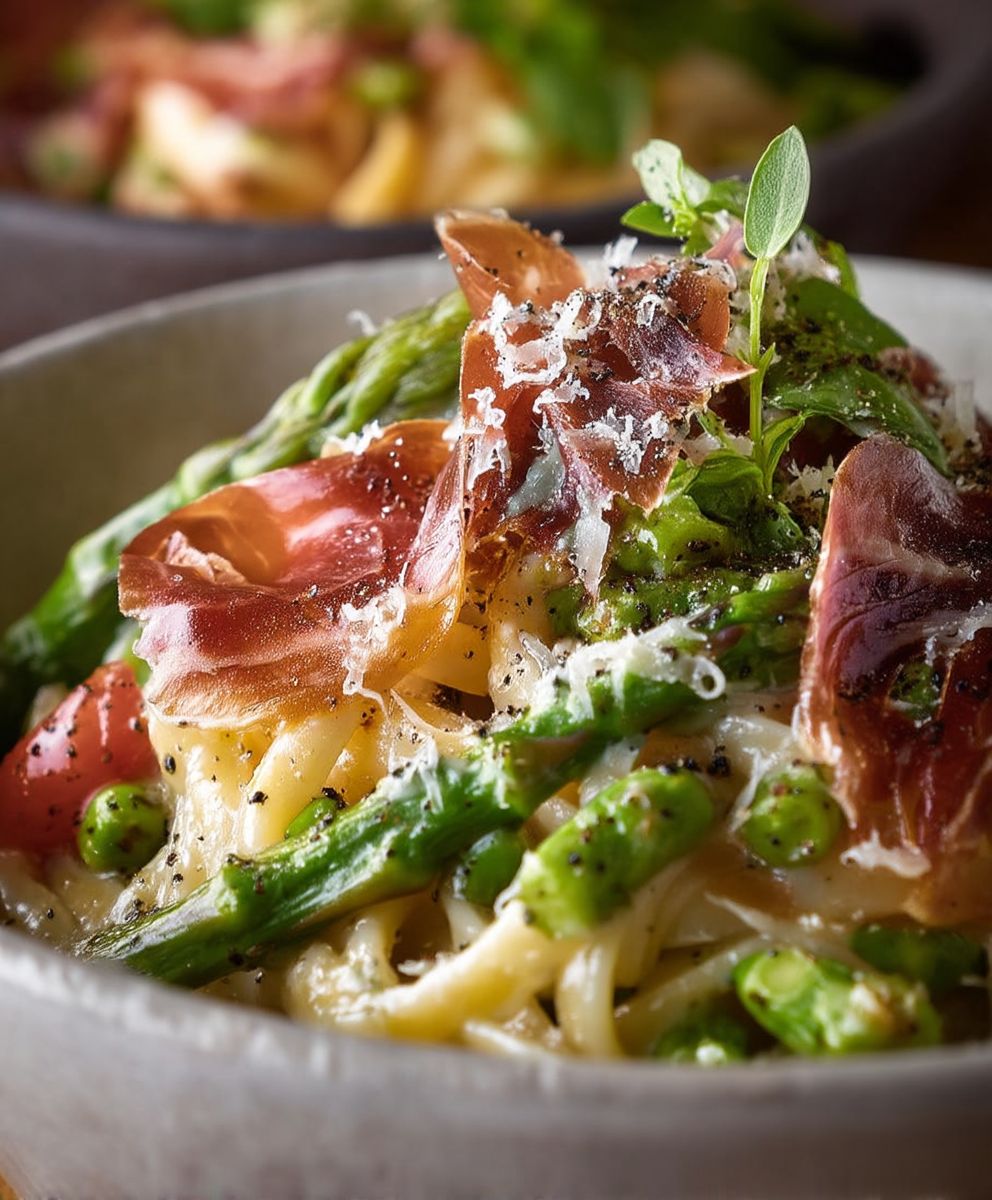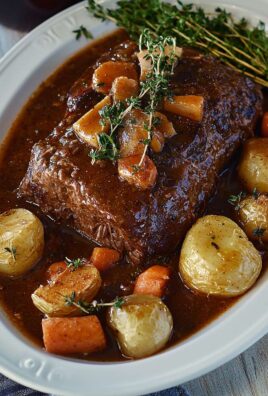Cacio e Pepe Spring Veggies: Imagine the creamy, peppery perfection of classic Cacio e Pepe, but bursting with the vibrant freshness of spring. This isn’t just another pasta dish; it’s a celebration of seasonal flavors, a symphony of textures, and a surprisingly simple weeknight meal that will transport your taste buds to the Roman countryside.
Cacio e Pepe, meaning “cheese and pepper” in several central Italian dialects, boasts a history as humble as its ingredients. Legend has it that shepherds in the Roman countryside relied on this simple yet satisfying dish, using readily available ingredients that wouldn’t spoil during long periods away from home. The beauty of Cacio e Pepe lies in its minimalist approach just pasta, Pecorino Romano cheese, and black pepper. But don’t let the simplicity fool you; mastering the technique is key to achieving that perfectly emulsified, velvety sauce.
So, why do people adore Cacio e Pepe? It’s the harmonious blend of sharp, salty cheese, the pungent kick of freshly ground black pepper, and the satisfying chew of perfectly cooked pasta. Now, imagine adding the sweetness of peas, the earthy notes of asparagus, and the delicate crunch of fava beans to that already irresistible combination. That’s precisely what Cacio e Pepe Spring Veggies brings to the table a delightful twist on a timeless classic. This recipe elevates the traditional dish, making it a complete and nutritious meal that’s both comforting and invigorating. I think you’ll find that this version of Cacio e Pepe is a welcome addition to your spring cooking repertoire.
Ingredients:
- Pasta: 1 pound spaghetti (or bucatini, if you’re feeling adventurous!)
- Cheese: 4 ounces Pecorino Romano cheese, finely grated (and I mean *finely* we want it to melt beautifully!)
- Black Pepper: 2-3 tablespoons freshly cracked black pepper (trust me, fresh is key here!)
- Pasta Water: Reserved from cooking the pasta (don’t throw it out it’s liquid gold!)
- Olive Oil: 2 tablespoons extra virgin olive oil
- Garlic: 2 cloves garlic, minced
- Asparagus: 1 pound asparagus, trimmed and cut into 1-inch pieces
- Peas: 1 cup fresh or frozen peas
- Fava Beans: 1 cup shelled fava beans (optional, but adds a lovely touch!)
- Lemon Zest: 1 teaspoon lemon zest (for brightness!)
- Salt: To taste (be mindful of the saltiness of the Pecorino)
Preparing the Spring Vegetables:
- Blanch the Fava Beans (if using): If you’re using fava beans, bring a small pot of salted water to a boil. Add the fava beans and blanch for 1-2 minutes, until the outer skins loosen. Drain the beans and immediately plunge them into an ice bath to stop the cooking process. Once cooled, gently squeeze each bean to remove it from its outer skin. This step is a bit tedious, but the result is worth it the fava beans will be incredibly tender and flavorful.
- Prepare the Asparagus: Wash the asparagus thoroughly. Snap off the tough ends of the asparagus spears (they’ll naturally break where they become tender). Cut the remaining asparagus into 1-inch pieces. I like to cut the tips a bit longer for visual appeal.
- Mince the Garlic: Peel and mince the garlic cloves. Make sure they are finely minced to avoid any large, overpowering pieces in the final dish.
Cooking the Pasta and Creating the Sauce:
- Cook the Pasta: Bring a large pot of salted water to a rolling boil. Add the spaghetti (or bucatini) and cook according to package directions until al dente. Remember to reserve about 1-2 cups of pasta water before draining! This is crucial for creating the creamy sauce.
- Toast the Black Pepper: While the pasta is cooking, heat a large skillet over medium heat. Add the freshly cracked black pepper to the dry skillet and toast for 2-3 minutes, or until fragrant. Be careful not to burn the pepper, as it will become bitter. Toasting the pepper enhances its flavor and aroma.
- Sauté the Garlic and Asparagus: Add the olive oil to the skillet with the toasted black pepper. Add the minced garlic and sauté for about 30 seconds, until fragrant but not browned. Add the asparagus pieces and sauté for 3-4 minutes, until they are tender-crisp.
- Add the Peas and Fava Beans: Add the peas (fresh or frozen) and the prepared fava beans (if using) to the skillet with the asparagus. Cook for another 2-3 minutes, until the peas are heated through and the fava beans are warmed.
- Create the Cheese and Pepper Paste: While the vegetables are cooking, in a medium bowl, combine about half of the grated Pecorino Romano cheese with about 1/2 cup of the reserved pasta water. Whisk vigorously until a smooth, creamy paste forms. This is the base of our Cacio e Pepe sauce. You may need to add a little more pasta water to achieve the desired consistency it should be thick but pourable.
- Combine Everything: Drain the pasta, reserving the pasta water. Immediately add the drained pasta to the skillet with the vegetables. Toss to combine.
- Add the Cheese Sauce: Remove the skillet from the heat. Pour the cheese and pepper paste over the pasta and vegetables. Using tongs, quickly toss the pasta to coat it evenly with the sauce. The residual heat from the pasta will melt the cheese and create a creamy, emulsified sauce. If the sauce is too thick, add a little more reserved pasta water, a tablespoon at a time, until you reach the desired consistency. It’s important to work quickly here to prevent the cheese from clumping.
- Incorporate Remaining Cheese: Add the remaining grated Pecorino Romano cheese to the pasta and toss again to combine. This will add extra flavor and richness to the dish.
- Season to Taste: Taste the pasta and adjust the seasoning as needed. You may need to add a little salt, but be mindful of the saltiness of the Pecorino cheese. Add more black pepper if you like a stronger pepper flavor.
- Add Lemon Zest: Stir in the lemon zest for a bright, fresh flavor.
Serving:
- Serve Immediately: Cacio e Pepe is best served immediately, while the sauce is still creamy and the pasta is hot.
- Garnish (Optional): Garnish with a sprinkle of extra grated Pecorino Romano cheese and a few grinds of fresh black pepper. You can also add a drizzle of olive oil for extra richness.
- Enjoy!: Serve the Cacio e Pepe with Spring Vegetables in bowls and enjoy! This dish is simple yet incredibly flavorful, and the addition of the spring vegetables adds a lovely freshness and vibrancy.
Tips for Success:
- Use High-Quality Ingredients: The quality of the ingredients is crucial for Cacio e Pepe. Use good quality Pecorino Romano cheese and freshly cracked black pepper.
- Don’t Overcook the Pasta: Cook the pasta al dente, as it will continue to cook slightly in the sauce.
- Reserve Enough Pasta Water: The pasta water is essential for creating the creamy sauce. Don’t be afraid to use it!
- Work Quickly: The cheese sauce can clump if it’s not tossed with the pasta quickly enough. Work efficiently to ensure a smooth, creamy sauce.
- Adjust the Seasoning: Taste the pasta and adjust the seasoning as needed. Don’t be afraid to add more salt or pepper to your liking.
- Experiment with Vegetables: Feel free to experiment with other spring vegetables, such as ramps, morels, or fiddlehead ferns. Just be sure to adjust the cooking time accordingly.
- Cheese Matters: Pecorino Romano is the traditional cheese. While Parmesan can be used in a pinch, the flavor profile will be different. Pecorino has a sharper, saltier flavor that is key to the dish.
- Pepper Power: Don’t skimp on the pepper! It’s a defining characteristic of Cacio e Pepe.
- Water is Key: The starchy pasta water is what emulsifies the cheese and pepper into a creamy sauce. Don’t underestimate its importance.
- Temperature Control: Removing the pan from the heat before adding the cheese is crucial to prevent clumping. The residual heat is enough to melt the cheese without causing it to seize up.
Variations:
- Spicy Cacio e Pepe: Add a pinch of red pepper flakes to the skillet with the garlic for a spicy kick.
- Cacio e Pepe with Guanciale: Add crispy guanciale (cured pork cheek) to the dish for extra flavor and richness. Cook the guanciale in the skillet before adding the garlic and vegetables.
- Cacio e Pepe with Truffle: Add a drizzle of truffle oil or shaved truffles to the dish for a luxurious touch.

Conclusion:
This isn’t just another pasta dish; it’s a celebration of spring, a symphony of flavors, and a ridiculously easy weeknight meal all rolled into one. I truly believe this Cacio e Pepe Spring Veggies recipe is a must-try for anyone looking to elevate their pasta game with minimal effort and maximum impact. The creamy, cheesy sauce clings perfectly to the al dente pasta and the vibrant, slightly sweet spring vegetables, creating a harmonious blend that will have you reaching for seconds (and maybe even thirds!).
What makes this recipe so special? It’s the simplicity. We’re talking about a handful of ingredients, a straightforward technique, and a result that tastes far more complex than it actually is. The pecorino romano cheese provides that sharp, salty bite that’s characteristic of Cacio e Pepe, while the freshly cracked black pepper adds a warm, aromatic spice. But the real magic happens when you introduce the spring vegetables. The asparagus, peas, and zucchini bring a touch of sweetness and freshness that perfectly complements the richness of the cheese and pepper. It’s a delightful dance of flavors and textures that will awaken your taste buds and leave you feeling satisfied.
But don’t just take my word for it! I encourage you to get into the kitchen and experience the magic for yourself. This recipe is incredibly versatile, so feel free to get creative with your serving suggestions and variations.
Serving Suggestions & Variations:
* Protein Power: Add grilled chicken, shrimp, or sausage for a heartier meal. The smoky flavor of grilled protein pairs beautifully with the creamy sauce and fresh vegetables.
* Spice It Up: If you’re a fan of heat, add a pinch of red pepper flakes to the sauce for an extra kick.
* Lemon Zest: A sprinkle of lemon zest adds a bright, citrusy note that complements the cheese and vegetables perfectly.
* Herb Garden: Garnish with fresh herbs like parsley, basil, or chives for added flavor and visual appeal.
* Vegetable Swap: Feel free to substitute other spring vegetables like fava beans, artichoke hearts, or ramps, depending on what’s in season and available in your area. Just be sure to adjust the cooking time accordingly.
* Wine Pairing: A crisp, dry white wine like Sauvignon Blanc or Pinot Grigio would be a perfect accompaniment to this dish.
I’m confident that you’ll love this Cacio e Pepe Spring Veggies recipe as much as I do. It’s a quick, easy, and delicious way to enjoy the flavors of spring. And the best part? It’s a crowd-pleaser that’s perfect for weeknight dinners, weekend gatherings, or even a special occasion.
So, what are you waiting for? Grab your ingredients, put on your apron, and get cooking! I can’t wait to hear about your experience. Please share your photos and comments on social media using [Your Hashtag] and let me know what variations you tried. I’m always looking for new and exciting ways to elevate this classic dish. Happy cooking! I am sure that you will love this recipe and it will become a staple in your kitchen. Don’t forget to rate the recipe and leave a comment below! Your feedback is greatly appreciated.
Cacio e Pepe Spring Veggies: A Delicious and Easy Recipe
Cacio e Pepe with a spring twist! Asparagus, peas, and optional fava beans elevate this classic pasta into a light and flavorful dish.
Ingredients
- 1 pound spaghetti (or bucatini)
- 4 ounces Pecorino Romano cheese, finely grated
- 2-3 tablespoons freshly cracked black pepper
- 1-2 cups Reserved pasta water
- 2 tablespoons extra virgin olive oil
- 2 cloves garlic, minced
- 1 pound asparagus, trimmed and cut into 1-inch pieces
- 1 cup fresh or frozen peas
- 1 cup shelled fava beans (optional)
- 1 teaspoon lemon zest
- Salt to taste
Instructions
- Blanch Fava Beans (if using): Boil fava beans in salted water for 1-2 minutes. Plunge into an ice bath, then remove outer skins.
- Prepare Asparagus: Wash asparagus, snap off tough ends, and cut into 1-inch pieces.
- Mince Garlic: Peel and finely mince garlic cloves.
- Cook Pasta: Cook spaghetti in boiling salted water until al dente. Reserve 1-2 cups of pasta water.
- Toast Black Pepper: Toast black pepper in a dry skillet over medium heat for 2-3 minutes, until fragrant.
- Sauté Garlic and Asparagus: Add olive oil to the skillet with pepper. Sauté garlic for 30 seconds, then add asparagus and sauté for 3-4 minutes, until tender-crisp.
- Add Peas and Fava Beans: Add peas and fava beans to the skillet. Cook for 2-3 minutes, until heated through.
- Create Cheese and Pepper Paste: In a bowl, combine half of the Pecorino Romano cheese with 1/2 cup of reserved pasta water. Whisk until smooth and creamy, adding more pasta water if needed.
- Combine Everything: Drain pasta and add it to the skillet with vegetables. Toss to combine.
- Add Cheese Sauce: Remove skillet from heat. Pour cheese and pepper paste over pasta and vegetables. Toss quickly to coat evenly. Add more pasta water if the sauce is too thick.
- Incorporate Remaining Cheese: Add remaining Pecorino Romano cheese and toss to combine.
- Season to Taste: Taste and adjust seasoning with salt and pepper.
- Add Lemon Zest: Stir in lemon zest.
- Serve Immediately: Garnish with extra cheese and pepper, if desired.
Notes
- Use high-quality Pecorino Romano cheese and freshly cracked black pepper.
- Cook pasta al dente.
- Reserve enough pasta water.
- Work quickly to prevent cheese from clumping.
- Adjust seasoning to taste.
- Experiment with other spring vegetables.
- Pecorino Romano is the traditional cheese.
- Don’t skimp on the pepper!
- The starchy pasta water is what emulsifies the cheese and pepper into a creamy sauce.
- Removing the pan from the heat before adding the cheese is crucial to prevent clumping.






Leave a Comment